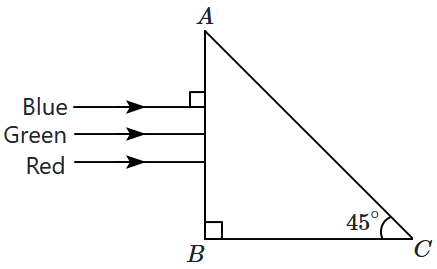An air bubble in a glass slab with a refractive index \(1.5\) (near-normal incidence) is \(5~\text{cm}\) deep when viewed from one surface and \(3~\text{cm}\) deep when viewed from the opposite surface. The thickness (in \(\text{cm}\)) of the slab is:
1.
\(8\)
2.
\(10\)
3.
\(12\)
4.
\(16\)
A person can see objects clearly only when they lie between \(50\) cm and \(400\) cm from his eyes. In order to increase the maximum distance of distinct vision to infinity, the type and power of the correcting lens, the person has to use, will be:
| 1. | convex, \(+2.25\) D | 2. | concave, \(-0.25\) D |
| 3. | concave, \(-0.2\) D | 4. | convex, \(+0.5\) D |
An astronomical refracting telescope will have large angular magnification and high angular resolution when it has an objective lens of:
| 1. | small focal length and large diameter. |
| 2. | large focal length and small diameter. |
| 3. | large focal length and large diameter. |
| 4. | small focal length and small diameter. |
| 1. | \(46.0\text{cm}\) | 2. | \(50.0\text{cm}\) |
| 3. | \(54.0\text{cm}\) | 4. | \(37.3\text{cm}\) |
| 1. | \(45^{0},~\sqrt{2}\) | 2. | \(30^{0},~\sqrt{2}\) |
| 3. | \(30^{0},~\frac{1}{\sqrt{2}}\) | 4. | \(45^{0},~\frac{1}{\sqrt{2}}\) |
In an astronomical telescope in normal adjustment, a straight line of length \(L\) is drawn on the inside part of the objective lens. The eye-piece forms a real image of this line. The length of this image is \(l.\) The magnification of the telescope is:
1. \(\frac{L}{l}+1\)
2. \(\frac{L}{l}-1\)
3. \(\frac{L+1}{l-1}\)
4. \(\frac{L}{l}\)

The prism will:
| 1. | separate the blue colour part from the red and green colour. |
| 2. | separate all three colours from one another. |
| 3. | not separate the three colours at all. |
| 4. | separate the red colour part from the green and blue colours. |
Two identical thin plano-convex glass lenses (refractive index = \(1.5\)) each having radius of curvature of \(20\) cm are placed with their convex surfaces in contact at the centre. The intervening space is filled with oil of a refractive index of \(1.7\). The focal length of the combination is:
1. \(-20\) cm
2. \(-25\) cm
3. \(-50\) cm
4. \(50\) cm
| 1. | \(180^\circ-3A\) | 2. | \(180^\circ-2A\) |
| 3. | \(90^\circ-A\) | 4. | \(180^\circ+2A\) |
If the focal length of the objective lens is increased then the magnifying power of:
| 1. | microscope will increase but that of the telescope decrease. |
| 2. | microscope and telescope both will increase. |
| 3. | microscope and telescope both will decrease. |
| 4. | microscope will decrease but that of the telescope will increase. |






